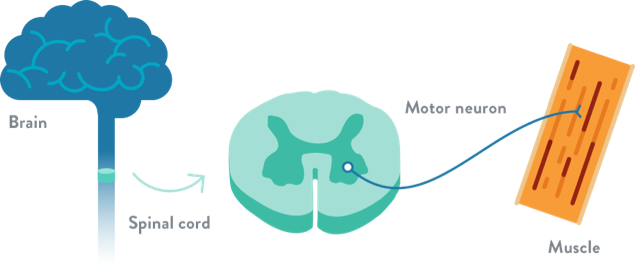


-
Argentina (Español)

-
Australia (English)

-
Bahrain (English)

-
Chile (Español)

-
Deutschland (Deutsch)

-
Europe (English)

-
France (Français)

-
Greece (Ελληνικά)

-
Italia (Italiano)

-
日本 (日本語)

-
대한민국 (한국어)

-
Kuwait (English)

-
Oman (English)

-
Polska (Polskie)

-
Qatar (English)

-
Saudi Arabia (English)

-
Spain (Español)

-
Sverige (Svenska)

-
台灣 (中文)

-
United States (English)

-
UAE (English)

Spinal muscular atrophy (SMA) explained
SMA is a rare and debilitating autosomal recessive neuromuscular disease characterised by motor neuron degeneration and loss of muscle strength1,2
Epidemiology


What is the effect of SMA?
Lower motor neurons are important cells involved in motor function7






Watch and learn about the genetic cause of SMA
The genetic deficit underlying SMA is well characterised
The role of the survival motor neuron 1 (SMN1) gene is to produce SMN protein, a protein essential for motor neuron survival and which is highly expressed in the
spinal cord.1,8
In SMA, homozygous mutations or deletions of the SMN1 gene produce a shortage of SMN protein, which causes degeneration of motor neurons in the spinal cord.9,10
SMA requires multidisciplinary medical care11
Because the presentation and progression of SMA may vary, comprehensive care involves the participation of multiple disciplines to manage the symptoms of the disease. A typical care team may involve a neurologist, respiratory physician, physiotherapist, orthopaedist and dietitian.11
Until recently, SMA management was focussed on managing complications, but with treatment now available and ongoing research into new therapeutic targets, the way SMA is managed is set to change dynamically.
Watch and learn
Experts discuss the evolving landscape of SMA care and the place of new treatments.
- Lunn MR and Wang CH. Lancet 2008; 371: 2120–33.
- Darras BT et al. Neuromuscular Disorders of Infancy, Childhood, and Adolescence: A Clinician’s Approach. 2nd ed. London, UK: Elsevier; 2015.
- Darras B. Pediatr Clin N Am 2015; 62: 743–66.
- D'Amico A et al. Orphanet J Rare Dis 2011; 6: 71.
- Butchbach M. Front Mol Biosci 2016; 3: 7.
- Kaczmarek A et al. Expert Opin Investig Drugs 2015; 24: 867–81.
- Prior TW and Finanger E. Spinal muscular atrophy. NCBI Bookshelf Web site. http://www.ncbi.nlm.nih.gov/books/NBK1352/?report=printable. Updated December 22, 2016. Accessed October 2017.
- Kolb SJ and Kissel JT. Arch Neurol 2011; 68: 979–84.
- Lefebvre S et al. Cell 1995; 80: 155–65.
- Genetics Home Reference. SMN1. https://ghr.nlm.nih.gov/gene/SMN1. Published October 17, 2017. Accessed October 2017.
- Wang CH et al. J Child Neurol 2007; 22: 1027–49.
- Farrar MA et al. Ann Neurol 2017; 81: 355–68.
